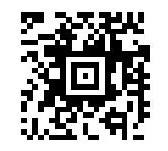Aztec Code
The Aztec code is an advanced form of two-dimensional (2D) barcode noted for its ability to store large amounts of data in a relatively small space. It was originally developed by the U.S. company Honeywell and has spread widely in a variety of applications, including those related to labeling and traceability.
Key features of the Aztec code
- High Storage Capacity: One of the main advantages of the Aztec code is its ability to store a large amount of information. This makes it ideal for situations where complex data, such as text, numbers, web links or even images, need to be encoded.
- High Reliability: Because of its advanced coding structure, Aztec code offers high reading reliability. Even if the code is damaged or partially obscured, barcode readers can often successfully recover data.
- Flexibility: The Aztec code can be used in a variety of applications, including product tracking, e-ticket, ID documents, asset management, and more. It is suitable for a wide range of industries.
- Customizable Design: Users can customize the Aztec code design to suit their specific needs. This includes choosing colors, sizes and information to be encoded.
Common applications of the Aztec code
- Tracking and Logistics: Aztec code is widely used for product tracking and logistics management, enabling efficient inventory tracking and management.
- Electronic Ticketing: It is often used in electronic tickets for events, public transportation and elsewhere, enabling quick and secure access.
- Health Sector: In the medical field, Aztec code is used for specimen labeling and medical record management.
- Marketing and Promotions: It can be incorporated into promotional materials, linking customers to multimedia content or Web pages.
Aztec Code Symbol
The Aztec code is a type of two-dimensional (2D) code that uses a square array of dots or cells called a “module” to represent data. The basic structure of the Aztec code consists of several key parts:
- Central Area: The central area of the Aztec code consists of a square-shaped module within which the data is encoded. This module can vary in size depending on the amount of data to be stored.
- Outer Border: Surrounding the central area, there is an outer border consisting of a series of concentric “rings” of modules. These rings serve to define the boundaries of the barcode and provide a reference for reading.
- Finder Patterns: Within the outer border, there are special modules known as “reference points” or “finder patterns” that help barcode readers locate and decode the Aztec code. These reference points have a specific configuration and are placed at key locations within the outer border.
- Quiet Zone: Preceding the outer border, there is a “silence” or “quiet zone” that must be free of any other visual elements or interference. This zone allows barcode readers to clearly distinguish the Aztec code from the surrounding background.
- Error Correction Information: The Aztec code may include error correction information that allows data to be recovered even if the code is damaged in part. This error correction information is usually stored in specific modules within the code.
- Encoded Data: The main part of the Aztec code is the array of modules in the central area. Data is encoded within this matrix according to a specific algorithm, which may include text, numbers, Web links, or other types of information.
The Aztec code structure is highly configurable and can be customized to fit the specific needs of each application. Array size, number of reference points, data density and other features can be adjusted to optimize the performance and storage capacity of Aztec code.
Aztec code is known for reliable reading, even under non-optimal conditions.

